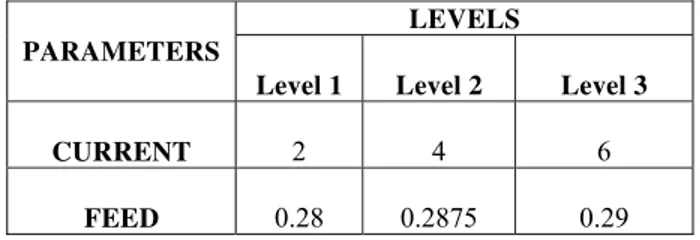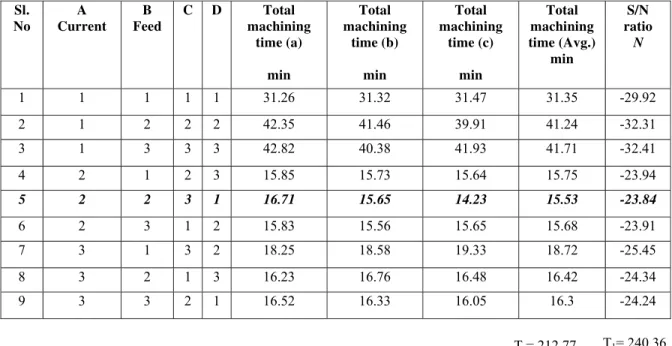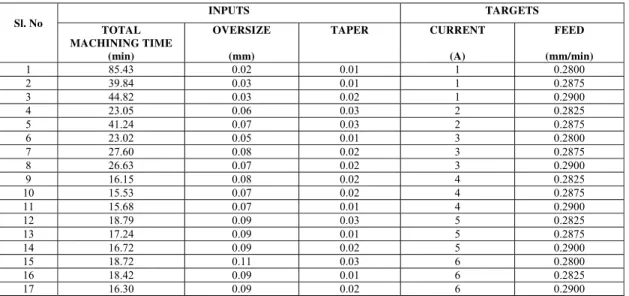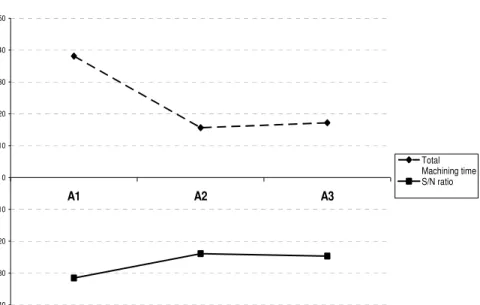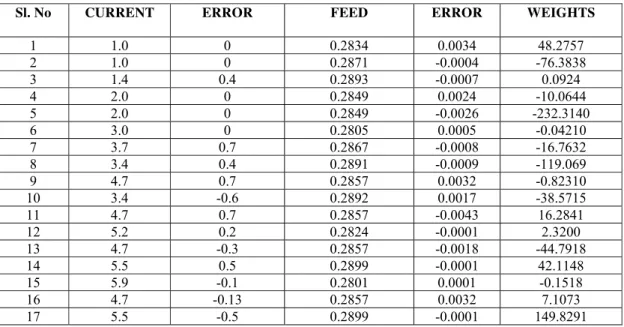OPTIMIZATION OF OPERATING
PARAMETERS FOR EDM PROCESS
BASED ON THE TAGUCHI METHOD
AND ARTIFICIAL NEURAL NETWORK
A.Thillaivanan1
P. Asokan2
K.N.Srinivasan3
R.Saravanan4
Professor Professor &Head
Scientist
Professor 1
Department of Mechanical Engineering Mohamed Sathak Engineering College,kilakarai-623806 2
Department of Production Engineering, National Institute of Technology, Trichy-620015. 3
Scientist-F, Central Electro Chemical Research Institute (CECRI), Karaikudi, Tamilnadu.India. 4
Department of Mechanical engineering, Bannariamman Institute of Technology, Sathiyamangalam.
Abstract:
In this paper the complexity of electrical discharge machining process which is very difficult to determine optimal cutting parameters for improving cutting performance has been reported. Optimization of operating parameters is an important step in machining, particularly for operating unconventional machining procedure like EDM.
A suitable selection of machining parameters for the electrical discharge machining process relies heavily on the operators’ technologies and experience because of their numerous and diverse range. Machining parameters tables provided by the machine tool builder can not meet the operators’ requirements, since for an arbitrary desired machining time for a particular job, they do not provide the optimal machining conditions. An approach to determine parameters setting is proposed. Based on the Taguchi parameter design method and the analysis of variance, the significant factors affecting the machining performance such as total machining time, oversize and taper for a hole machined by EDM process, are determined.
Artificial neural networks are highly flexible modeling tools with an ability to learn the mapping between input variables and output feature spaces. The superiority of using artificial neural networks in modeling machining processes make easier to model the EDM process with dimensional input and output spaces. On the basis of the developed neural network model, for a required total machining time, oversize and taper the corresponding process parameters to be set in EDM by using the developed and trained ANN are determined.
1. Introduction:
Electrical Discharge Machining (EDM) was first introduced in the 1940's as a crude device used to cut broken machining tools from expensive in-process parts. Since that time EDM has become a sophisticated and indispensable technology, revolutionizing the tool, die, and mold making industries, and making significant inroads into the production of highly accurate, intricate and difficult to machine production parts.
In electrical discharge machining, it is important to select machining parameters for achieving optimal machining performance. Usually, the desired machining parameters are determined based on experience or handbook values. However, this does not ensure that the selected machining parameters result in optimal or near optimal machining performance for that particular electrical discharge machine and environment. In earlier work to solve this task, Lin, Wang, Yan, Tarng [2] used the Taguchi method with fuzzy logic as an efficient approach to determine the optimal machining parameters in the electrical discharge machining process.
The Taguchi method can optimize performance characteristics through the settings of process parameters and reduce the sensitivity of the system performance to sources of variation. As a result, the Taguchi method has become a powerful tool in the design of experiment methods [2]. However, most published Taguchi applications to date have been concerned with the optimization of a single performance characteristic. Handling the more demanding multiple performance characteristics is still an interesting research problem [2].
process can be greatly simplified [3]. As a result, the method developed in this study is very suitable for practical use in a machine shop.
In the past decade, neural networks have been shown to be the highly flexible modeling tools with capabilities on learning the mathematical mapping between input variables and output features for nonlinear systems [6]. Also, the superior performances of neural networks for modeling machining processes have been published elsewhere. In these, multi-layer Perceptions based on back-propagation (BP) technique have been employed for monitoring and modeling the reported processes.
Wang, Gelgele, Yi Wang, Yuan and Fang developed a hybrid artificial neural network and genetic algorithm methodology for modeling and optimization of electro-discharge machining [7]. The hybridization approach is aimed not only at exploiting the strong capabilities of the two tools, but also at solving manufacturing problems that are not amenable for modeling using traditional methods. Based on an experimental data, the model was tested with satisfactory results. The developed methodology with the model is highly beneficial to manufacturing industries, such as aerospace, automobile and tool making industries.
A better process model is established based on neural networks by comparing the predictions from different models under the effect of change of polarity between the electrode and the work materials in the EDM process. Initially, pertinent process variables affecting the MRR, namely the polarity of the electrode, the discharge time, the peak current, and the materials of both the tool and the workpiece, were screened by making use of Taguchi method on design of experiments [8]. The DOE experimental data were later used for training the various process models. Finally, more experimental verification on the established process models was conducted, and comparisons among the models, including a statistical process model, were analyzed.
2. Problem Formulation 2.1 Design Variables
The formulation of an optimization problem begins with identifying the underlying design variables, which are primarily varied during the optimization process. In this paper current and feed are considered as design variables.
2.2 Constraints
The constraints represent some functional relationship among the design variables and other design satisfying certain physical phenomenon and certain resource are greater than or equal to, a resource value. In this paper, oversize and taper of the EDM hole are considered as constraints.
2.3 Objective function
The objective function can be of two kinds. Either the objective function is to be minimized or it has to be maximized. In this paper, minimization of total machining time is considered as objective function.
3. Experimental equipment and design
An EDM machine, developed by SPARKONIX (I) LTD. was used as the experimental machine. The work material, electrode and the other machining conditions were as follows (1) Workpiece (anode), Stainless Steel 340C; (2) Electrode (cathode), Tungsten Ø 1.6mm; (3) Dielectric fluid, Kerosene; (4) Workpiece height, 50mm; (5) Workpiece length, 100mm.
A total of two machining parameters (current and feed) were chosen for the controlling factors and each parameters have levels as shown in Table 1.
Table 1 Process parameters and their levels
PARAMETERS LEVELS
Level 1 Level 2 Level 3 Level 4 Level 5 Level 6
CURRENT (A)
1 2 3 4 5 6
FEED (mm/min)
The machining results after the EDM process under the designed machining conditions are evaluated in terms of the following measured machining performance: (1) total machining time (min); (2) oversize (mm); (3) taper (mm).
4. Solution Methodology
Taguchi Method is a new engineering design optimization methodology that improves the quality of existing products and processes and simultaneously reduces their costs very rapidly, with minimum engineering resources and development man-hours. The Taguchi Method achieves this by making the product or process performance "insensitive" to variations in factors such as materials, manufacturing equipment, workmanship and operating conditions.
Neural networks are developed using the current understanding of the biological nervous system. The key to the development of a neural network in the domain of engineering design and group technology is its ability to store a large set of patterns as memories that can be recalled. During recall this memory can be excited with a key pattern containing a part of information about a particular member of a stored pattern set. The particular pattern set can be recalled through the association of the key pattern and the information memorized. Neural networks have learning and generalization abilities. They are able to learn the correlation between input examples and the expected outcome, and more importantly, to generalize the relationship.
4.1 Taguchi Method
Experimental design methods [9] were developed originally by Fisher [10]. However, classical experimental design methods are too complex and not easy to use. Furthermore, a large number of experiments have to be carried out as the number of the process parameters increases. To solve this important task, the Taguchi method uses a special design of orthogonal array to study the entire parameter space with only a small number of experiments. The experimental results are then transformed into a signal-to-noise (S/N) ratio. The S/N ratio can be used to measure the deviation of the performance characteristics from the desired values. Usually, there are three categories of performance characteristics in the analysis of the S/N ratio: the lower-the-better, the higher-the-lower-the-better, and the nominal-the-better. Regardless of the category of the performance characteristic, a larger S/N ratio corresponds to better performance characteristic. Therefore, the optimal level of the process parameters is the level with the highest S/N ratio. Furthermore, a statistical analysis of variance (ANOVA) is performed to identify the process parameters that are statistically significant. The optimal combination of the process parameters can then be predicted based on the above analysis.
4.1.1 Parameters and their Levels:
The process parameters of the EDM taken up for experiment and their levels for the optimization based of Taguchi method are given below in the Table 2
Table 2 Parameters and their levels for Taguchi method
PARAMETERS
LEVELS
Level 1 Level 2 Level 3 CURRENT 2 4 6
FEED 0.28 0.2875 0.29
4.1.2 Selection of Orthogonal Array
By knowing the parameters and their corresponding levels we can chose a standard OA, based on the Degrees of freedom.
4.1.2.1 Degrees of freedom
We know, the number of D.O.F. for a factor = Number of levels – 1
2+ 2 = 4.
4.1.2.2 Orthogonal Array
A three-level L9 OA is selected for conducting the experiment, because in our consideration we have each 3 level for both the factors current and feed. Hence we should pick a OA from a three-level OA and in that L9 OA is selected because the total D.O.F is 4 which is less than the D.O.F. of the selected L9 OA which is (No. of trials – 1) 8.
The table 3 below shows the standard L9 OA:
Table 3 L9 Orthogonal array
Sl. No
A Current
B Feed
C D Total machining time (a)
min
Total machining
time (b) min
Total machining
time (c) min
Total machining time (Avg.)
min
S/N ratio
N
1 1 1 1 1 31.26 31.32 31.47 31.35 -29.92
2 1 2 2 2 42.35 41.46 39.91 41.24 -32.31
3 1 3 3 3 42.82 40.38 41.93 41.71 -32.41
4 2 1 2 3 15.85 15.73 15.64 15.75 -23.94
5 2 2 3 1 16.71 15.65 14.23 15.53 -23.84
6 2 3 1 2 15.83 15.56 15.65 15.68 -23.91
7 3 1 3 2 18.25 18.58 19.33 18.72 -25.45
8 3 2 1 3 16.23 16.76 16.48 16.42 -24.34
9 3 3 2 1 16.52 16.33 16.05 16.3 -24.24
The numbers in the current (A), column are nothing but the levels of Current. Similarly for feed (B) and column C and D are the interactions between the factors, in our case since there are no interactions between the factors columns C and D are just dummy columns i.e. it has no influence on the experiment.
The performance characteristic i.e. total machining time are taken from the experiment conducted for every set of current and feed making a total of 9 trials.
4.2 Artificial Neural Network
An artificial neural network is an information-processing system that has certain performance characteristics in common with biological neural networks. Artificial neural networks have been developed as generalizations of mathematical models of human cognition or neural biology, based on the assumptions that: 1. Information processing occurs at many simple elements called neurons.
2. Signals are passed between neurons over connection links.
3. Each connection link has an associated weight, which, in a typical neural net, multiplies the signal transmitted.
4. Each neuron applies an activation function (usually nonlinear) to its net input (sum of weighted input signals) to determine its output signal.
In the past decades, numerous studies have been reported on the development of neural networks based on different architectures. Basically, one can characterize neural networks by its important features, such as the architecture, the activation functions, and the learning algorithms. Each category of the neural networks would have its own input output characteristics, and therefore it can only be applied for modeling some specific processes. In this work, ANN is employed for modeling and determination of optimal parameters for the EDM process.
4.2.1 Architecture
Neural networks are in general categorized by their architecture. The number of hidden layers is critical for the convergence rate at the stage of training the network parameters. Empirically speaking, one hidden layer
should be sufficient in the multi-layered networks because the number of neurons is typically assumed to be dominant in the networks. In other words, the number of neurons must be determined by an optimization method. In this work, a multi-layer backpropagation network is adopted to model the EDM process. To be in particular, a four layer BP network with 6,14,18,2 neurons in each of the respective layers. This particular configuration gives the output values, which are nearer to the target set values with very little error.
MATLAB® software, which is a high-performance language for technical computing, is used for modeling and developing of neural network.
4.2.2 Activation Functions
The connections among the neurons are made by signal links designated by corresponding weightings. Each individual neuron is represented by an internal state, namely the activation, which is functionally dependent of the inputs. In general, the Sigmoid functions (S-shaped curves), such as logistic functions and hyperbolic tangent functions, are adopted for representing the activation. In the networks, a neuron sends its activation to the other neurons for information exchange via signal links. In this work, two different functions for activation have been employed. They are Linear transfer function and Tan-sigmoid transfer function, in which the former is used for the output layer and the latter is used for the all hidden layers.
Fig 1 Linear transfer function
Fig 2 Tan-sigmoid transfer function
4.2.3 Algorithm
There are many variations of the backpropagation algorithm. The simplest implementation of backpropagation learning updates the network weights and biases in the direction in which the performance function decreases most rapidly - the negative of the gradient. One iteration of this algorithm can be written as
Xk+1 = Xk – αk gk
where Xk+1 is a vector of current weights and biases, Xk is the current gradient, and gk is the learning rate.
There are two different ways in which this algorithm can be implemented: incremental mode and batch mode. In the incremental mode, the gradient is computed and the weights are updated after each input is applied to the network. In the batch mode all of the inputs are applied to the network before the weights are updated.
4.2.4 Training
There are two backpropagation training algorithms: gradient descent, and gradient descent with momentum.These two methods are often too slow for practical problems. There are several high performance algorithms that can converge from ten to one hundred times faster than the algorithms mentioned above. All of the faster algorithms operate in the batch mode.
4.2.4.1 Resilient Backpropagation
Multilayer networks typically use sigmoid transfer functions in the hidden layers. These functions are often called "squashing" functions, since they compress an infinite input range into a finite output range. Sigmoid functions are characterized by the fact that their slope must approach zero as the input gets large. This causes a problem when using steepest descent to train a multilayer network with sigmoid functions, since the gradient can have a very small magnitude; and therefore, cause small changes in the weights and biases, even though the weights and biases are far from their optimal values.
The purpose of the resilient backpropagation training algorithm is to eliminate these harmful effects of the magnitudes of the partial derivatives. In this work, resilient BP network is used.
4.2.5 Data sets
The data sets given as input to the developed network is given in the Table 4.
4.2.6 Testing
The trained sets should be tested by giving another data set which is taken from within the range of the dataset given for the training. The dataset given for testing is shown in the Table 5.
Table 4 Data set given for training
Sl. No
INPUTS TARGETS TOTAL
MACHINING TIME (min)
OVERSIZE (mm)
TAPER CURRENT
(A)
FEED (mm/min)
1 85.43 0.02 0.01 1 0.2800
2 39.84 0.03 0.01 1 0.2875
3 44.82 0.03 0.02 1 0.2900
4 23.05 0.06 0.03 2 0.2825
5 41.24 0.07 0.03 2 0.2875
6 23.02 0.05 0.01 3 0.2800
7 27.60 0.08 0.02 3 0.2875
8 26.63 0.07 0.02 3 0.2900
9 16.15 0.08 0.02 4 0.2825
10 15.53 0.07 0.02 4 0.2875
11 15.68 0.07 0.01 4 0.2900
12 18.79 0.09 0.03 5 0.2825
13 17.24 0.09 0.01 5 0.2875
14 16.72 0.09 0.02 5 0.2900
15 18.72 0.11 0.03 6 0.2800
16 18.42 0.09 0.01 6 0.2825
17 16.30 0.09 0.02 6 0.2900
Table 5 Data set given for testing
Sl. No
INPUTS TARGETS
TOTAL MACHINING TIME
(min)
OVERSIZE (mm)
TAPER CURRENT
(A)
FEED (mm/min)
1 42.86 0.03 0.02 1 0.2825
2 31.35 0.02 0.02 2 0.28
3 41.71 0.03 0.03 2 0.29
4 31.86 0.01 0.01 3 0.2825
5 15.74 0.03 0.03 4 0.28
6 17.02 0.1 0.02 5 0.28
7 16.49 0.09 0.03 6 0.2875
5. Results and discussion 5.1 Taguchi Method 5.1.1 Orthogonal Array
The result of L9 OA from Table 3, shows that the optimal machining parameters are the current atlevel
5.1.2 ANOVA:
The result of ANOVA for both total machining time and S/N ratio from Table 4 and Table 5, whose % contribution is 92.874 and 95.611 respectively, shows that the parameter current is the most significant factor that affect the performance characteristic.
5.1.3 Graphs:
The graphs for the total machining time Vs S/N ratio for both the parameters current (Fig 3) and feed (Fig 4) are plotted.
5.2 Artificial Neural Network
The result of ANN for both training phase and testing phase are presented below.
5.2.1 Training
The Table 6 shows the results after training the network. The value of the outputs i.e. current and feed obtained after training and their error when compared with that of the target values and the weights are presented
.
Total Machining time Vs S/N ratio for Current (A)
-40 -30 -20 -10 0 10 20 30 40 50
A1 A2 A3
Total Machining time S/N ratio
Fig 3 Total machining time Vs S/N ratio for current (A)
Fig 4 Total machining time Vs S/N ratio for Feed (B) Total machining time Vs S/N ratio for Feed (B)
-20 -10 0 10 20 30
B1 B2 B3
Table 6 Training results of the network
Sl. No CURRENT ERROR FEED ERROR WEIGHTS
1 1.0 0 0.2834 0.0034 48.2757
2 1.0 0 0.2871 -0.0004 -76.3838
3 1.4 0.4 0.2893 -0.0007 0.0924
4 2.0 0 0.2849 0.0024 -10.0644
5 2.0 0 0.2849 -0.0026 -232.3140
6 3.0 0 0.2805 0.0005 -0.04210
7 3.7 0.7 0.2867 -0.0008 -16.7632
8 3.4 0.4 0.2891 -0.0009 -119.069
9 4.7 0.7 0.2857 0.0032 -0.82310
10 3.4 -0.6 0.2892 0.0017 -38.5715
11 4.7 0.7 0.2857 -0.0043 16.2841
12 5.2 0.2 0.2824 -0.0001 2.3200
13 4.7 -0.3 0.2857 -0.0018 -44.7918
14 5.5 0.5 0.2899 -0.0001 42.1148
15 5.9 -0.1 0.2801 0.0001 -0.1518
16 4.7 -0.13 0.2857 0.0032 7.1073
17 5.5 -0.5 0.2899 -0.0001 149.8291
5.2.2 Testing
The Table 7 shows the results after testing the network. The value of the outputs i.e. current and feed obtained after testing and their error when compared with that of the target values are presented. Testing results are important because this is the phase where we can get the optimal machining parameters by feeding the required input conditions, in this case total machining time, oversize and taper.
In simple words, for obtaining a required total machining time, oversize and taper we can get the corresponding process parameters to be set in EDM by using the developed and trained ANN.
Table 7 Testing results of the network
Sl. No CURRENT ERROR FEED ERROR
1 0.56 0.46 0.2807 -0.0018
2 1.56 -0.36 0.2807 0.0007
3 1.50 -0.50 0.2851 -0.0049
4 2.60 -0.40 0.2829 0.0004
5 3.50 -0.50 0.2851 0.0051
6 5.08 0.08 0.2907 0.0107
7 6.18 0.18 0.2876 0.0001
6. Conclusion
In this paper a practical method of optimizing cutting parameters for electrical discharge machining under the minimum total machining time based on Taguchi method and Artificial neural network is presented. This methodology is not only time saving and cost effective but also efficient and precise in determining the machining parameters. It is found that current has a significant influence on the total machining time. As a result, the performance characteristic total machining time can be improved through this approach.
In addition, in this paper a feedforward-backpropagation neural network is developed for getting the parameters i.e. current and feed for a required total machining time, oversize and taper of a hole to be machined by EDM, which are given as inputs. The collected experimental data are used for training and testing the network. The results are presented in the previous section.
7. References
[1]. P.J. Ross, Taguchi Techniques for Quality Engineering, McGraw-Hill, New York, 1988.
[2]. J.L. Lin, K.S. Wang, B.H. Yan, Y.S. Tarng (2000) “Optimization of the electrical discharge machining process based on the Taguchi
method with fuzzy logics “ Journal of Material Processing and Technology, Vol. 102, pp 48-55.
[3]. Y.S. Liao, J.T. Huang, H.C. Su (1997) “A study on the machining-parameters optimization of wire electrical discharge machining”
Journal of Material Processing and Technology, Vol. 72, pp 487-493.
[4]. J.L. Lin, C.L. Lin (2002) “The use of the orthogonal array with grey relational analysis to optimize the electrical discharge machining
process with multiple performance characteristics” Int. J. of Machine Tools & Manufacture. Vol. 42, pp 237-244.
[5]. Kuo-Ming Tsai, Pei-Jen Wang (2001) “Semi-empirical model of surface finish on electrical discharge machining” Int. J. of Machine
Tools & Manufacture. Vol. 41, pp 1455-1477.
[6]. [6] Jun Qu, Albert J. Shih (2002) “Development of the cylindrical wire electrical discharge machining process, part 1: Concept,
Design, and Material removal rate”, Journal of Manufacturing Science and Engineering, Vol. 124, pp 702-707.
[7]. Jun Qu, Albert J. Shih (2002) “Development of the cylindrical wire electrical discharge machining process, part 2: Concept, Design,
and Material removal rate”, Journal of Manufacturing Science and Engineering, Vol. 124, pp 708-714.
[8]. D.C. Montgomery, Design and Analysis of Experiments, Wiley, Singapore, 1991.
[9]. R.A. Fisher, Statistical Methods for Research Worker, Oliver & Boyd, London, 1925.
[10].J.A. Sanchez, L.N. Lopez de Lacalle, A. Lamikiz, U. Bravo (2002) “Dimensional accuracy optimization of multi-stage planetary
EDM” Int. J. of Machine Tools & Manufacture, Vol. 42, pp 1643-1648.
[11].Scott Dan, Boyino, Sreedhar, Rajurkar (1991) “Analysis and optimization of parameter combinations in wire electrical discharge
machining”, International Journal of Production Research, Vol. 29, No110 pp 2189 – 2207
[12].H.S.Yan, R.S.Lee, And Y.C.Yang (1995) “An algorithm for surface design and tool path generation in wire electrical discharge
machining”, International Journal of Machine Tool Manufacture, Vol. 35, No.12 pp.1703- 1714.
[13].A.B.PURI, B.BHATTACHARYA (2003)“Analysis and optimization of geometrical inaccuracy due to wire lag phenomenon in wire
electrical discharge machining” International Journal of Machine Tool Manufacture 2003, Vol. 43, No.2 pp 151-159.
[14].Masters, A.R. Khoei and D.T. Gethin (1999) “The Application of Taguchi Methods to the Aluminium Recycling Process” Proc. 4th
ASM International Conference on The Recycling of Metals, pp 115-124.
[15].J. Paulo Davim (2003) “ Design optimization of cutting parameters for turning metal matrix composites based on the orthogonal
arrays” Journal of Material Processing and Technology, Vol. 132, pp 340-344.
[16].J.H. Zhang, T.C. Lee, W.S. Lau (1997) "Study on the electro-discharge machining of a hot pressed aluminum oxide based ceramic"
Journal of Material Processing Technology, Vol. 63, pp 908–912.
[17].Y.S. Tarng, S.C. Ma, L.K. Chung (1995) "Determination of optimal cutting parameter in wire electrical discharge machining"
International Journal of Machine Tools and Manufacture, Vol 35, No.12, pp1693–1701.
[18].Kuo-Ming Tsai, Pei-Jen Wang (2001) "Predictions on surface finish in electrical discharge machining based upon neural network
models" International Journal of Machine Tools and Manufacture, Vol 41, pp 1385-1403.
[19].Chang,S.H,Hwang,J.R,Doong,J.L,(2010) ‘Optimization of the injection moulding process of short glass fiber reinforced
polycarbonate composites using grey relational analysis, ” Journal of Material Processing and Technology, Vol. 132, pp 340-344.
[20].Mohd Amri Lajis, Mohd Radzi,H.C.D(2009) ‘The Implementation of Taguchi Method on EDM Process of Tungsten Carbide’,

